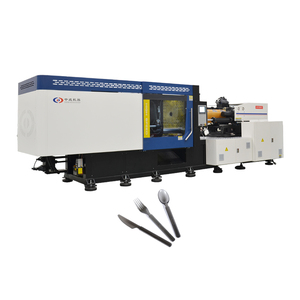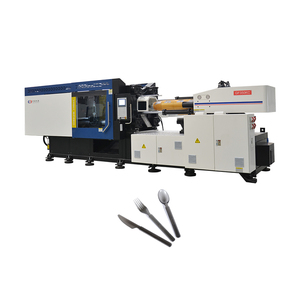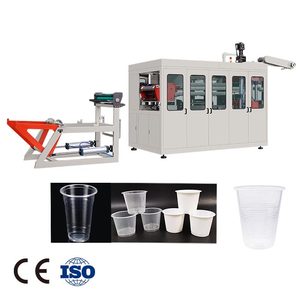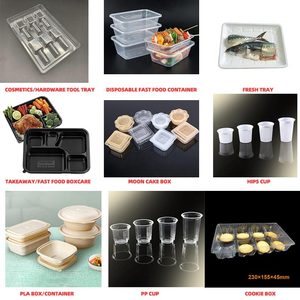
All categories
Featured selections
Trade Assurance
Buyer Central
Help Center
Get the app
Become a supplier

(1763 products available)




















Market Overview: The global plastic processing machinery market, which includes plastic cutlery making machines, reached a significant size of US$36.4 billion in 2023, with expectations to grow to US$50.4 billion by 2032, reflecting a compound annual growth rate (CAGR) of 3.7% during this period, according to Research and Markets. The increasing demand for disposable plastic products, particularly in the food service industry, has been a major driver behind this growth. As consumer behavior shifts towards convenience and hygiene, the need for efficient production methods for plastic cutlery is paramount. Additionally, the rise in automated manufacturing processes is enhancing productivity and efficiency, further boosting the market for plastic cutlery making machines.
Industry Insights: Key players in the plastic processing machinery sector, such as Japan Steel Works and Husky Injection Molding Systems, are innovating to meet the rising demand for energy-efficient and high-quality production systems. The integration of advanced technologies, including artificial intelligence and automation, is also transforming the manufacturing landscape, allowing for greater customization and reduced waste. Furthermore, the growing trend towards eco-friendly alternatives poses challenges, as manufacturers of plastic cutlery making machines must adapt to evolving consumer preferences for sustainable packaging solutions. In regions like North America and Europe, increasing regulations on plastic usage are prompting manufacturers to explore biodegradable materials, thus reshaping market dynamics and creating new niche opportunities within the industry.
A plastic cutlery making machine is used to produce spoons, forks, and knives from plastic materials. The machines mold and shape thermoplastic resins into various forms of cutlery. Below are the two main types of machines used in this industry.
Injection molding machine
This machine makes cutlery by injecting melted plastic into a mold. The process has several stages. First, the plastic pellets are fed into a heated barrel. The heater melts the pellets into liquid plastic. Then, a screw moves the liquid plastic toward a mold cavity. The mold closes, and the plastic cools into the desired shape. The mold opens, and the finished cutlery part is ejected. This cycle repeats to make many identical pieces of cutlery. Injection molding is suitable for making complex shapes with thin walls. It is fast and cost-effective once the mold is made. However, the molds are expensive and take time to create. This machine is ideal for producing large quantities of plastic cutlery quickly and efficiently.
Thermoforming machine
A thermoforming machine makes cutlery by heating plastic sheets until soft and molding them. First, the operator loads a plastic sheet onto the machine. Then, a heater brings the sheet to the forming temperature. After that, the heated sheet is shaped using a mold. Finally, the cutlery is trimmed from the excess plastic. This method is less costly than injection molding for small runs or simpler designs. However, it is not as precise or fast. This machine is suitable for making plates, bowls, and cups.
The design of a plastic cutlery making machine involves various elements that ensure the machine's efficiency and performance.
Design of the Die:
A cutlery forming die is designed to form plastic into the desired shapes of spoons, forks, and knives. The design of this die takes into account the intricate details of the cutlery items and their overall dimensions. The die is made in two parts that fit together to form the cutlery shapes. When the plastic cools down sufficiently, the two parts of the die are separated, and the shaped plastic cutlery is removed.
Cooling Systems:
Adequate cooling is essential for maintaining the speed of production. Cooling systems are designed to cool and solidify hot molten plastic quickly. These systems usually have water or some other coolant flowing through tubes or channels in the machine. They help in reducing the temperature of the plastic material rapidly so that it solidifies and the cutlery can be removed in a short time. This is important for increasing the speed of producing plastic cutlery and, thus, the overall efficiency of the machine.
Control Systems:
Modern plastic cutlery machines are designed to have advanced control systems that enable users to monitor and regulate different process parameters. These control systems usually have sensors, switches, and displays that allow the operators to set the temperature, pressure, and timing for the operation of the machine. With such systems, the machine can automatically adjust itself according to the parameters set by the operator. This increases the precision and repeatability of the plastic cutlery making process. It also makes the machine easier to use and operate.
Plastic cutlery is an important part of many industries. Plastic cutlery making machines are used to meet the demand for these utensils. They are used in the following industries and scenarios:
Catering Industry
The catering industry makes a lot of plastic cutlery daily. Catering plastic cutlery machines help the industry to produce the cutlery quickly. The plastic knives, spoons, and forks made are used during parties and events.
Fast Food Chains
Fast food restaurants provide convenience and a quick dining experience. They use plastic cutlery so that customers can eat fast. These chains need a reliable supply of plastic cutlery. They often collaborate with plastic cutlery manufacturers.
Food Packaging Industry
The food packaging industry often uses plastic cutlery with packaged meals. With the rise of takeout and delivery services, the demand for plastic cutlery within food packaging has increased.
Catering Equipment Suppliers
Catering equipment suppliers sell plastic cutlery to caterers, event planners, and restaurants. They supply disposable cutlery for large events and everyday dining needs.
Disposable Tableware Manufacturers
Disposables tableware makers produce plastic cutlery as part of a broader line of disposable products. They focus on creating utensils that are easy to use and throw away.
Airlines and Cruise Lines
Airlines and cruise lines serve food to passengers and travelers. They use plastic cutlery to ensure the dining experience is clean and convenient in transit.
School Cafeterias and Institutions
Schools and institutions use plastic cutlery in their cafeterias. They serve a lot of students daily. Using plastic cutlery saves time and reduces the need for washing utensils.
Outdoor Activities and Event Organizers
The demand for plastic cutlery has increased for picnics, camping, and outdoor events. Event organizers supply plastic cutlery to participants to make dining easy in outdoor settings.
Healthcare Facilities
Hospitals and nursing homes use plastic cutlery for patient meals and in cafeterias. Plastic cutlery is easy to clean and helps to maintain hygiene in healthcare settings.
When choosing a plastic cutlery making machine, several key factors should be considered to ensure that it meets the needs and requirements. Firstly, one should determine the desired output capacity and production speed. It is essential to match the machine's capacity with the expected production volume to keep up with the demand. Secondly, considering the machine's automation level and ease of operation is crucial. Opting for a machine with user-friendly controls and automated processes can significantly reduce labor costs and minimize human errors.
Additionally, one should consider the material used for producing plastic cutlery and the machine's versatility. It is essential to ensure that the machine can work with various types of plastics, including biodegradable or compostable materials, if sustainability is a priority. Furthermore, one should look into the machine's maintenance requirements and availability of spare parts. Selecting a machine that is easy to maintain and has readily available spare parts can help minimize downtime and reduce maintenance costs.
Moreover, it is advisable to comply with relevant safety and environmental standards when choosing a plastic cutlery making machine. Ensuring that the machine meets the necessary safety features and environmental regulations can prevent potential legal issues and promote a safer working environment. Lastly, one should consider the total cost of ownership, including the initial purchase cost, installation expenses, operating costs, and potential upgrades. Conducting a thorough cost analysis can help determine the machine that offers the best value for money in the long run.
Q1: Can a plastic cutlery making machine produce different types of cutlery?
A1: Yes, these machines can make various cutlery, including spoons, forks, knives, and disposable straws.
Q2: What materials can be used with these machines?
A2: They usually work with polypropylene, polystyrene, and other thermoplastic materials.
Q3: How automatic is the machine?
A3: Some are fully automatic and need only manual input to start production, while others are semi-automatic and need manual intervention at various stages.
Q4: What is the production capacity of a plastic cutlery making machine?
A4: The capacity differs depending on the machine type. Some can produce thousands of pieces per hour.
Q5: What are the machine's power requirements?
A5: The power requirement varies depending on the machine model and size. It can be anything from 10 to 100 kilowatts.
Q6: How much does a plastic cutlery making machine cost?
A6: Prices vary based on capacity, automation level, and machine model, ranging from $10,000 to $100,000.
Q7: How do buyers know the machine will last long?
A7: Look for machines with high-quality components and materials, and ask about the warranty period offered by the manufacturer.
Q8: How do plastic cutlery making machine operators stay safe?
A8: Operators should wear safety goggles, gloves, and hearing protection, among other PPEs, to stay safe from flying debris, noise, and heat.